In highschool I met a whole new world in the form of Caribbean immigrants and the amazing foods they ate at home.
Oxtail stew, jerk chicken, goat roti – these quickly became my favourites. The hotter the better.
In 1997, years after my first introduction to the many flavours (and peppers) of the world, I came to Ghana. I knew that one of the most important aspects of acculturation for me would be the food. And I wasn’t disappointed.
Ghanaian food is culinary world in and of itself and it’s citizens hold it as dear as their flag and anthem. To be Ghanaian is to eat fufu, banku, kenkey.
And there is no shortage of pepper. The soups, the stews and even the sides of fresh pepper with everything – just the thought of it gets my temples sweating and my mouth watering.
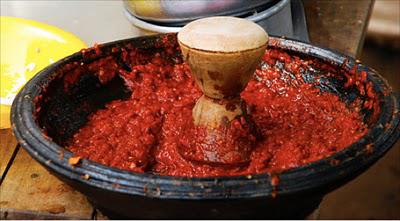
Below, a sample of Ghana food at it’s best (next installment will be the stranger, more difficult to get used to dishes!):
Ghanaian dishes usually consist of a starch as the main component, with an accompaniment of soup or stew.
Banku is my favorite. It's literally a ball of maize that has been processed and fermented - giving it a vinegary taste like one of my other favourites, Ethiopian injera.
Here is a pot of banku being made.
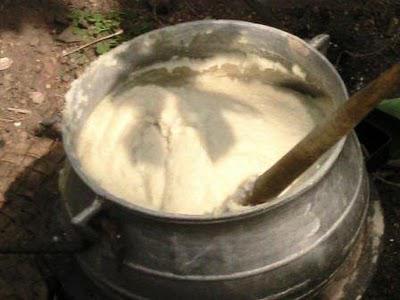
Banku is eaten either with a okro soup (quite slimy and definitely not one of my favs), or with fish and raw hot peppers, ground with tomato and onion. CUTLERY IS NOT ALLOWED! This is a 'dig in with your hands' affair!
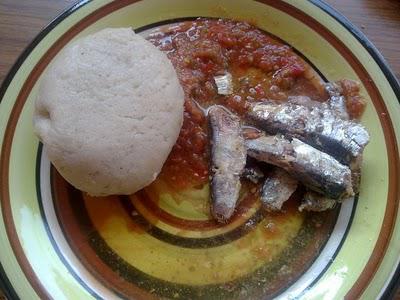
Arguably the best Ghanaian dish ever (in my mind) - is banku with tilapia fish. You get the whole fish - no fillets in Ghana! Again, it's all about sharing and eating with your hands. YUM!
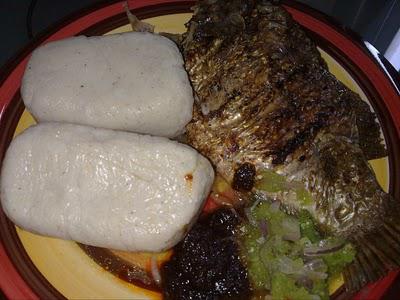
Here's a bowl of fufu. This is Ghana's national dish. The fufu itself is made of boiled and pounded starches - either plantain and cassava or yam. There are three main soups that it can be submersed in - groundnut (yes, peanut soup!), light soup (a pepper and tomato broth) or palm nut soup (made from the pulp of palm kernels). There is a real art to eating fufu and most obrunis are hopeless at it. The object is to plunge your hand into the hot soup, pull of a bit size piece of the fufu, manipulate it to crate a little well where a bit of soup can sit, and plop the whole thing in your mouth and swallow. No chewing! Personally i can't do it. So in order not to gag at the table and cause concern and disgust in all around me, I abstain... The soups are great though. Peppery and flavourful...

Kenkey is the food of the Ga tribe - those along the coast, in the main city Accra. It is similar to banku, in that it's made of maize, but it has a grainier texture and is made and stored in either corn husks, or in banana leaves (fante kenkey). It's served with fish and pepper. Filling and simple and transportable. A practical and filling food.
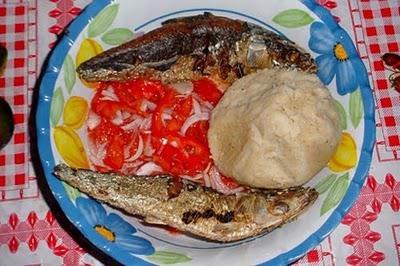
Then there's red red. This dish is usually the favorite of the less adventurous visitors. It is not as spicy as the others and the tastes and textures are less 'foreign' to obrunis. Red red is named for the red of the beans in the bean stew, and the red of the fried plantains that accompany the stew. The sweetness of the plantain compliments the rich bean stew perfectly. This is a delicious dish that is definitely NOT for the diet conscious. If anyone bothered to calculate calories in Ghana, I'm sure this dish would be off the charts! It could easily take on a Super Size Big Mac meal!
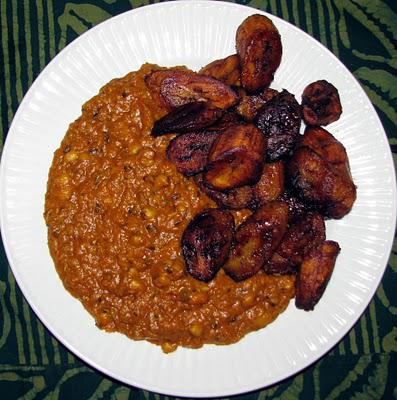
This dish is called omo tuo - which literally translates as 'rice gun' - but no one can explain why... The white ball is rice that has been well cooked and then pounded into this shape, to be submerged in soup. It's Ghana's answer to dim sum or the north American brunch. On any given Sunday around the country, you can pop into the little designated canteens and feast on omo tuo. The ladies will have bowls of soups and different types of meat, fish etc., and you basically build your own.
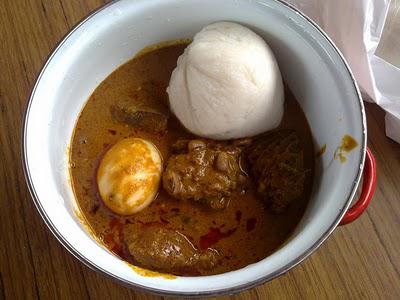
Here is a feast of apem (unripe plantains, boiled) with palaver sauce (a stew made with crushed pumpkin seeds, kontomire which is in the spinach family, and of course hot pepper, tomato and onion). The amazing buttery avocados in Ghana make a great accompaniment. Hands only, the more the better to share... Yum!
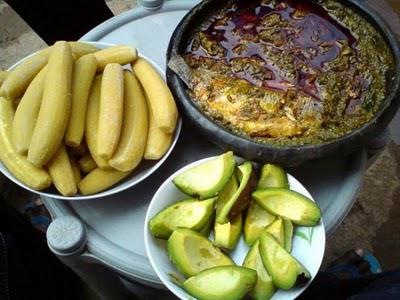
Wachee is a staple food in Ghana. Sold at many roadside stalls, it is the fast food of the people. It is made of red beans cooked together with rice, giving it the characteristic brownish appearance. It's another build your own deal, where you can choose from macaroni, tomato stews, boiled eggs, fish, meat and gari (a powder made from dried cassava).

Ampesi and garden egg stew is basically boiled unripe plantains (which taste a bit like boiled potatoes) with a stew made from small local yellow eggplants/aubergines. Fish is usually the meat in this stew. I like to make it with canned tuna - no fish bones for me!!!

Abolo is another maize based food - much less dense than banku or kenkey. It is like a semi sweet fluffy pancake that's eaten with tiny tiny fishes - pictured here - which are called 'one man thousand'. The fishes are deep fried and taste like some sort of chips.

Here is a snack that is as moreish as you can get. Roadside sellers can be seen every evening, cooking up a batch. It's called kelewele and is basically chunks of sweet ripe plantain, rolled in a mixture of garlic, ginger and hot pepper, then deep fried to a dark crispy brown, while the inside stays soft and sweet. It can be eaten alone or with groundnuts (peanuts), or pictured here with the local ice cream, Fan Ice. Delicious.

Last but not least is the grill. Ghana is obsessed with kebabs. Most events serve or sell various grilled meats, and most famous is the kebab. Ghanaians have perfected a dusting powder for the meat, made of hot pepper powder, peanut powder and garlic and ginger, that coats and browns on the meat. It's great. The only problem for me is when the meat itself is cow skin or goat head... but that's another post! :)

